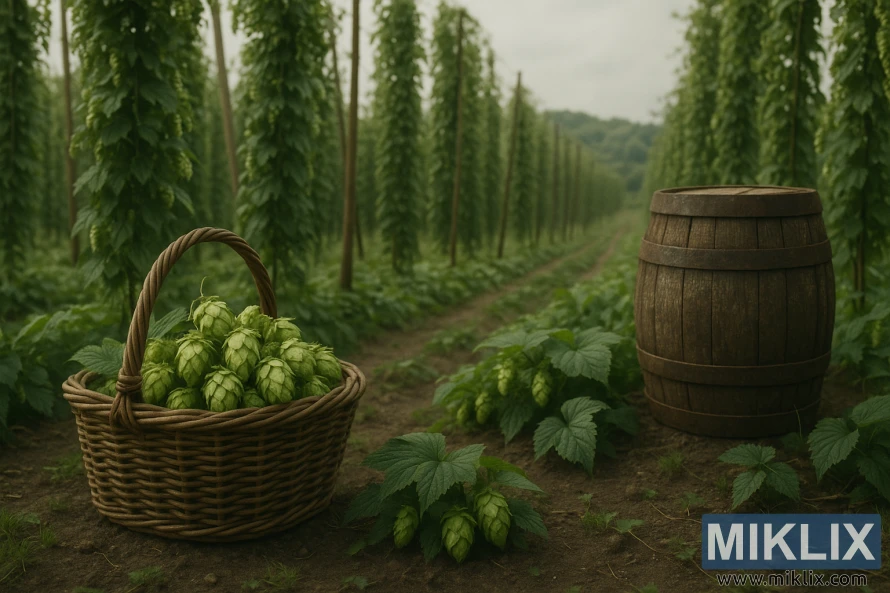Image: Traditional Sussex Hop Farm
Published: August 7, 2025 at 3:08:51 PM UTC
Last updated: September 27, 2025 at 9:07:07 AM UTC
A Sussex hop farm with fresh hops in a basket, tall trellises, and an oak barrel, reflecting tradition and challenges in regional hop growing.
The image unfolds like a page from the long and storied history of hop cultivation in the English countryside, an atmosphere steeped in both serenity and quiet industry. At the very heart of the scene lies a wicker basket, brimming with freshly harvested hop cones. Their vibrant green forms appear almost luminous under the soft, diffused daylight that filters across the field, each cone meticulously gathered and nestled together, promising a bounty of natural oils and resins essential to the brewer’s art. The cones’ papery bracts catch the light delicately, hinting at the lupulin-rich interiors that carry the promise of bitterness, aroma, and complexity in the beers to come. This humble basket, resting squarely on the well-trodden soil between neat rows of towering hop bines, embodies both tradition and utility, a simple vessel that connects the labor of the field directly to the brewing kettle.
Beside the basket stands a weathered oak barrel, its staves bearing the subtle marks of years, if not decades, of use. The barrel is more than a utilitarian object—it is a symbol of the continuum between agriculture and craft, the link between raw harvest and refined beverage. In its worn wood is etched the story of countless brews past, the quiet endurance of a tool that has been as vital to brewing as the hops themselves. Its presence in the field serves as a reminder of the cycles of labor and reward: the cones will soon be dried, processed, and stored, some destined for fermentation alongside malt and yeast, others perhaps packed away for future use. In this moment, the barrel represents both readiness and patience, the bridge between the immediacy of harvest and the long work of brewing and maturation.
The middle and background stretch into carefully aligned trellises, each supporting verdant curtains of hop bines climbing toward the sky. Their rhythmic rows draw the eye into the distance, creating a sense of order imposed upon the natural abundance. The sheer scale of the cultivation conveys the importance of this crop not only to local brewers but also to the identity of the region itself. The Sussex countryside, rolling gently toward distant hills, provides the perfect canvas for this agricultural tradition. Yet the landscape, beautiful as it is, carries inherent challenges. Subtle variations in soil composition, pockets of moisture, shifting weather patterns, and the perennial threat of pests remind the grower that hop farming requires not only diligence but adaptability. Each season, each row, each bine must be tended with a mixture of science, intuition, and experience to coax from them the finest cones possible.
The lighting of the scene contributes significantly to its mood. Soft, muted, and diffused by what appears to be a cloud-strewn sky, it strips away the harshness of midday glare and replaces it with a contemplative, almost pastoral calm. Shadows fall gently across the rows, highlighting textures without obscuring detail, emphasizing the lushness of the foliage while allowing the vibrant green of the cones to stand out in subtle contrast. This natural glow underscores the cyclical rhythm of farming life, the daily labor that begins and ends in harmony with the sun’s passage across the sky.
The overall composition of the image communicates more than the mechanics of hop farming—it conveys its spirit. There is a reverence for the process evident in every element, from the careful placement of the basket to the sturdy, dependable presence of the barrel. This is not an industrialized or hurried harvest; it is one rooted in patience, knowledge, and tradition. The atmosphere is one of balance: the quiet beauty of the English countryside set against the unglamorous but essential labor of cultivation, the fragility of the cones countered by the enduring resilience of wood and soil.
In essence, the photograph captures a moment of stillness at the intersection of nature and craftsmanship, a pause that honors the hop cone not simply as an agricultural product but as a vital cornerstone of brewing heritage. Here, amid rows of climbing bines and beneath the steady glow of soft light, lies the raw potential for ales infused with the distinct character of Sussex—earthy, aromatic, and deeply tied to the land from which they spring.
The image is related to: Hops in Beer Brewing: Sussex

